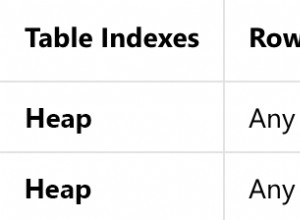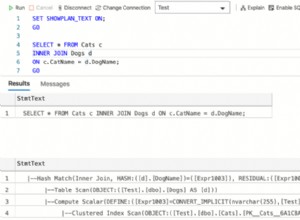Ho perso il tag mysql e ho scritto questa soluzione. Purtroppo, questo non funziona in MySQL in quanto non supporta le funzioni della finestra .
Lo pubblico comunque, dato che ci ho messo un po' di impegno. Testato con PostgreSQL. Funzionerebbe in modo simile con Oracle o SQL Server (o qualsiasi altro RDBMS decente che supporti le funzioni della finestra).
Impostazione di prova
CREATE TEMP TABLE v(id int, visit date);
INSERT INTO v VALUES
(444631, '2011-11-07')
,(444631, '2011-11-06')
,(444631, '2011-11-05')
,(444631, '2011-11-04')
,(444631, '2011-11-02')
,(444631, '2011-11-01')
,(444632, '2011-12-02')
,(444632, '2011-12-03')
,(444632, '2011-12-05');
Versione semplice
-- add 1 to "difference" to get number of days of the longest period
SELECT id, max(dur) + 1 as max_consecutive_days
FROM (
-- calculate date difference of min and max in the group
SELECT id, grp, max(visit) - min(visit) as dur
FROM (
-- consecutive days end up in a group
SELECT *, sum(step) OVER (ORDER BY id, rn) AS grp
FROM (
-- step up at the start of a new group of days
SELECT id
,row_number() OVER w AS rn
,visit
,CASE WHEN COALESCE(visit - lag(visit) OVER w, 1) = 1
THEN 0 ELSE 1 END AS step
FROM v
WINDOW w AS (PARTITION BY id ORDER BY visit)
ORDER BY 1,2
) x
) y
GROUP BY 1,2
) z
GROUP BY 1
ORDER BY 1
LIMIT 1;
Uscita:
id | max_consecutive_days
--------+----------------------
444631 | 4
Più veloce/più breve
In seguito ho trovato un modo ancora migliore. grp i numeri non sono continui (ma in continuo aumento). Non importa, dal momento che quelli sono solo un mezzo per un fine:
SELECT id, max(dur) + 1 AS max_consecutive_days
FROM (
SELECT id, grp, max(visit) - min(visit) AS dur
FROM (
-- subtract an integer representing the number of day from the row_number()
-- creates a "group number" (grp) for consecutive days
SELECT id
,EXTRACT(epoch from visit)::int / 86400
- row_number() OVER (PARTITION BY id ORDER BY visit) AS grp
,visit
FROM v
ORDER BY 1,2
) x
GROUP BY 1,2
) y
GROUP BY 1
ORDER BY 1
LIMIT 1;
Di più
- Un soluzione procedurale
per un problema simile.
Potresti essere in grado di implementare qualcosa di simile in MySQL . - Risposte strettamente correlate su dba.SE con ampia spiegazione qui e qui .
- E su SO:
GROUP BY e aggrega valori numerici sequenziali




